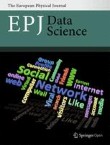2022 Citation Impact
3.6 - 2-year Impact Factor
4.4 - 5-year Impact Factor
1.625 - SNIP (Source Normalized Impact per Paper)
1.066 - SJR (SCImago Journal Rank)
2023 Speed
20 days submission to first editorial decision for all manuscripts (Median)
234 days submission to accept (Median)
2023 Usage
578,929 downloads
824 Altmetric mentions



